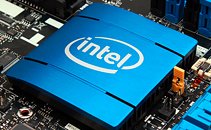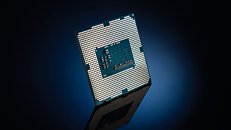- Joined
- Mar 25, 2009
- Messages
- 9,819 (1.70/day)
- Location
- 04578
| System Name | Old reliable |
|---|---|
| Processor | Intel 8700K @ 4.8 GHz |
| Motherboard | MSI Z370 Gaming Pro Carbon AC |
| Cooling | Custom Water |
| Memory | 32 GB Crucial Ballistix 3666 MHz |
| Video Card(s) | MSI RTX 3080 10GB Suprim X |
| Storage | 3x SSDs 2x HDDs |
| Display(s) | ASUS VG27AQL1A x2 2560x1440 8bit IPS |
| Case | Thermaltake Core P3 TG |
| Audio Device(s) | Samson Meteor Mic / Generic 2.1 / KRK KNS 6400 headset |
| Power Supply | Zalman EBT-1000 |
| Mouse | Mionix NAOS 7000 |
| Keyboard | Mionix |
For years Intel was able to maintain their endless tick-tock cycle however with the switch from 14nm to 10nm Intel realized all too late that they had bitten off more than they could chew. According to Robert Swan, Intel's Interim Chief Executive Officer and Chief Financial Officer, "we set out in the transition to 10 nm to attempt to scale much faster than we ever had at a time when I think most would argue the technology and the science and the challenges are more challenging they've ever been. So, we took a fairly aggressive scaling factor, roughly 2x of what the competitors do. So, we went for the analogy that a grand slam, I think, when the competition was hitting really solid singles."
Essentially Intel had hedged their bets that they could take a revolutionary step instead of the more typical evolutionary one thereby leaving their competition behind. Instead, it's resulted in the current situation that we are all very much aware of, that Intel is far behind their original predicted schedule. While that timeline has since been revised and they are now on course to release 10nm products in 2019, and 2020 Intel has also made it known that they plan to regain their leadership position as that transition begins.


In regards to supply constraints, Swan elaborated that they will continue to prioritize their Xeon product line first with their traditional small core and other devices coming second. Meaning those products will see continued supply shortages for the foreseeable future since that ties into Intel's eventual transition to 10nm. To help mitigate the issue, Intel has redeployed some of their 14nm equipment, but it is not enough to completely solve the supply problem. Right now they are trying to work with customers to figure out what constitutes actual demand rather than just inventory hoarding. Thus far Intel considers overall inventory healthy going from Q3 to Q4. For some customers this may be true, however for enthusiasts, that is not the case. Intel's latest Core 9000 series processors are in minimal supply having sold out pretty much everywhere making them little more than imaginary offerings for the PC gaming and enthusiast market. So while the inventory of certain products may be in a healthy state, you could say Intel's looking at the situation with rose-colored glasses.
You can check the entire transcript for more in-depth details from Intel at the source below.
View at TechPowerUp Main Site
Essentially Intel had hedged their bets that they could take a revolutionary step instead of the more typical evolutionary one thereby leaving their competition behind. Instead, it's resulted in the current situation that we are all very much aware of, that Intel is far behind their original predicted schedule. While that timeline has since been revised and they are now on course to release 10nm products in 2019, and 2020 Intel has also made it known that they plan to regain their leadership position as that transition begins.


In regards to supply constraints, Swan elaborated that they will continue to prioritize their Xeon product line first with their traditional small core and other devices coming second. Meaning those products will see continued supply shortages for the foreseeable future since that ties into Intel's eventual transition to 10nm. To help mitigate the issue, Intel has redeployed some of their 14nm equipment, but it is not enough to completely solve the supply problem. Right now they are trying to work with customers to figure out what constitutes actual demand rather than just inventory hoarding. Thus far Intel considers overall inventory healthy going from Q3 to Q4. For some customers this may be true, however for enthusiasts, that is not the case. Intel's latest Core 9000 series processors are in minimal supply having sold out pretty much everywhere making them little more than imaginary offerings for the PC gaming and enthusiast market. So while the inventory of certain products may be in a healthy state, you could say Intel's looking at the situation with rose-colored glasses.
You can check the entire transcript for more in-depth details from Intel at the source below.
View at TechPowerUp Main Site






